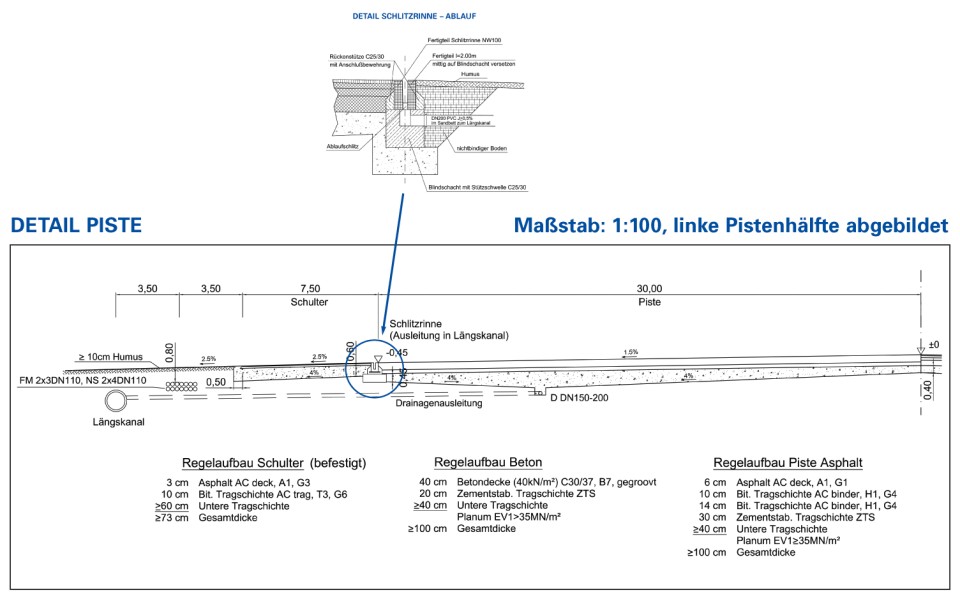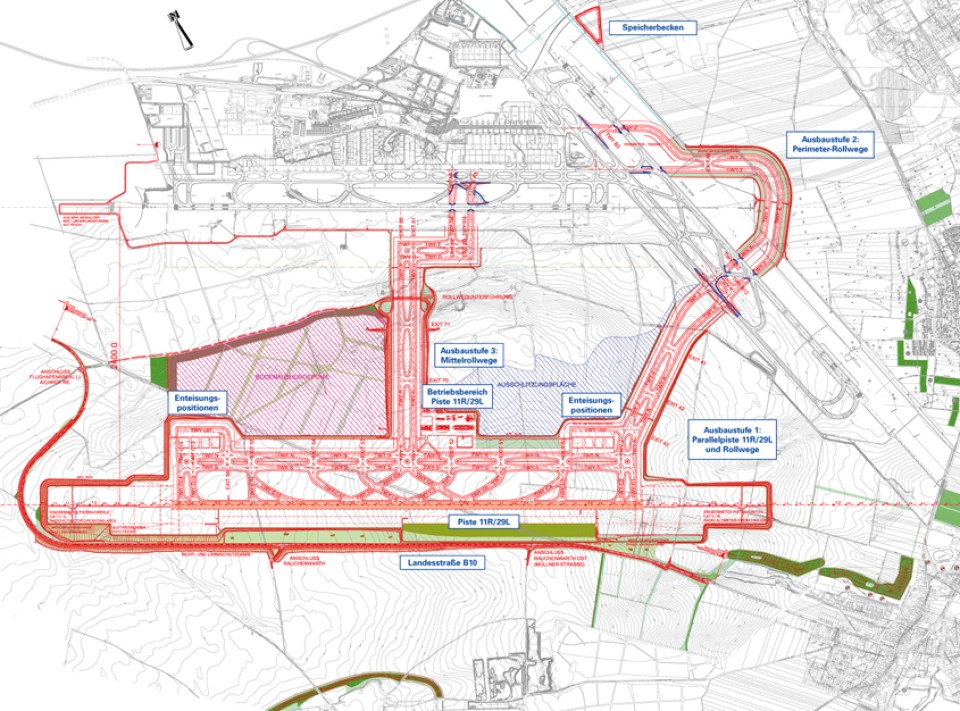Construction project 3rd runway
The third runway: An exciting engineering project
The planned location of the 3rd runway is the result of extensive discussions in the Mediation Procedure Vienna Airport. The groups involved, including for example the neighbouring communities and citizens' initiatives, have unanimously identified this situation - after a thorough examination of various development scenarios and variants - as the most environmentally friendly option.
The designation of the existing runway 11L/29R, for example, describes the location to the magnetic north pole - in this case 110°/290°. The effective runway length is 3,680 metres. The 3rd runway 11R/29L is located 2,400 metres to the south parallel to the existing runway 11L/29R. The 3rd runway will be equipped with a CAT III instrument landing system only in runway direction 29L.
A project with 43 sub-projects
An overview of the project components: 12 folders contain the planning details of the project. This ranges from terrain adjustment - earth masses are redistributed on the site - to taxiways and roads to air traffic control facilities, lighting systems, markings and signage. Water supply and sewage disposal facilities and a snow storage area for winter services are also planned, as are electrical and communications services. A number of buildings are also needed: a third fire station, another company fuel station, an aircraft de-icing station and a workshop building. In addition, a relocation of the B10 will be necessary.
Expansion stage Ia:
The first expansion stage is also the most extensive. As a prerequisite for the construction of the runway, terrain adjustment measures are planned and the B10 will be relocated. The runway and taxiway system 11R/29L will be constructed and connected to the existing runway 16/34. The 3rd runway will also be - channelised, just like all other movement areas at Vienna Airport - . This guarantees that waste water contaminated with pollutants will be purified in the sewage treatment plant. Unpolluted water is led directly into the Danube via a new canal diversion. All buildings planned in the operating area of the 3rd runway will also be constructed in expansion stage 1, as will the air traffic control facilities for CAT III operation. Internal road connections, infrastructure routes and a public path to the Katharinenhof area from the B10 are also part of this expansion stage. In parallel, noise and visual protection measures, clearing and planting measures as well as accompanying landscape conservation measures will be set.
Expansion stage Ib:
The second expansion stage is the perimeter taxiway pair for independent crossing of the existing runway system 11L/29R. Again, extensive accompanying measures (e.g. noise and visual protection measures, clearing and planting measures, landscape management accompanying measures, etc.) will be set.
Expansion stage II:
Finally, as the third and last stage, the construction of the central taxiway is planned, which will cross the existing runway 11/29 (which will then be called runway 11L/29R). The internal road connection to the airport's existing site will also be extended. A road tunnel will be constructed under the taxiway to provide access to the Katharinenhof. Terrain adjustment and drainage measures as well as accompanying measures are again planned.
Slope gradient: This is how flat a plain is
The slopes of taxiways, runways, aprons - in short, all aircraft movement areas - are clearly limited in ICAO (International Civil Aviation Organisation) rules. Extensive safety considerations are behind this.
The 3rd runway is planned with 0.24% mean longitudinal slope - starting from the west it "drops" at 0.208% and from the centre taxiway at 0.272%. According to ICAO, the runway could have a steeper slope: Indeed, the longitudinal slope for runways should not exceed 1.00% according to ICAO. The longitudinal slope of the taxiways to the 3rd runway is a maximum of 1.50%, which corresponds to the maximum longitudinal slope according to ICAO. As a result, terrain adjustments are necessary in the area of the 3rd runway. A total of approx. 49.5 million m3 of earth will be moved. On the one hand, this will be used to make the necessary structural fill and to build noise protection dams. On the other hand, a little more than half of it will go to an excavated soil landfill. The important thing is that all the earth material will be "moved" at the site itself - no removal is necessary.

Runway cross-section: a ribbon of concrete and asphalt
A runway - just like a road - also requires a substructure of different base layers. This is because a runway has to withstand the fully loaded aircraft waiting for clearance to take off, and it has to do so several hundred times a day.
For an A321-200, for example, that's up to 89 tonnes. That is why the threshold area - that part of the runway where the aircraft waits for take-off or touches down - is built in concrete. This is 707 m at each end of the runway. This prevents the pavement from being crushed. The larger part of the runway - namely 2,266 of 3,680 m - will be built in asphalt. To the right and left of the actual runway is the 7.5 m wide shoulder, which is also paved. In order to allow water to run off the runway in case of precipitation, the 60 m wide runway plus shoulders will also be built with a roof slope of 1.50% outwards. This causes the water to drain evenly on both sides.
The waste water from the 3rd runway is collected via a sewer system. There, the pollutant load is controlled. Uncontaminated wastewater is discharged into the Danube. Polluted wastewater is collected and treated at the wastewater treatment plant.
New operating area
Additional structures and facilities are required to operate the new runway and associated taxiways. The majority of these are planned in a common operating area approximately in the middle of the runway. These new facilities are necessary on the one hand for reasons of safety - minimum deployment times for the fire brigade - and on the other hand due to operational dependencies:
-
Fire station
-
Company petrol station
-
Workshop building
-
Winter service halls
-
Ground de-icing agent tank
-
Hangar aircraft de-icing equipment
-
Aircraft de-icing equipment station
-
Infrastructure building
The location of these buildings and facilities is primarily a matter of ensuring the shortest possible distances between the equipment sheds and the place where the equipment is used.
